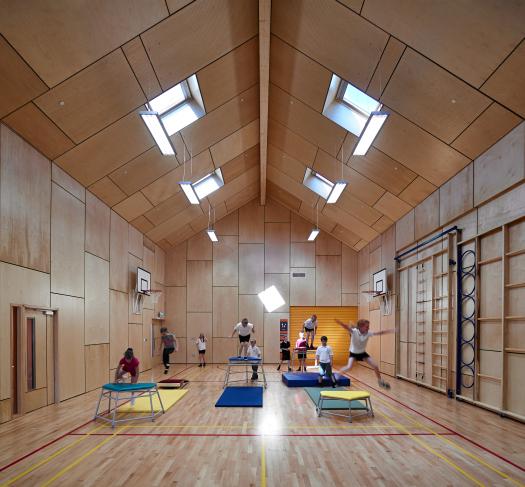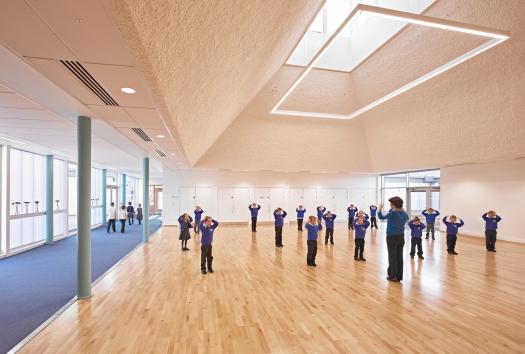New ESFA specification guidelines – are you up to date?

Meet Richard Aylen, our Technical Manager. In a new series of technical articles, Richard will be sharing his expertise and keeping us up to date with all things wood flooring. First up, he explains the new set of guidelines set by the ESFA, The Education and Skills Funding Agency, crucial knowledge for architects, specifiers and contractors involved in building and refurbishing schools.
For schools and education facilities, there are usually three overwhelmingly important factors to consider when it comes to flooring: performance, longevity and cost. This is true for sports floors as well as for floors throughout a school, and a balance between those three factors is of crucial consideration to specifiers. If a school or education facility is applying for funding to upgrade or build new facilities, there is a new set of guidelines to follow as part of the specification process. Familiarising yourself with these new guidelines means you are well equipped to advise clients in the education sector on how best to secure funding, and crucially, end up with a high quality, high performing floor.
The Education and Skills Funding Agency, (ESFA), is an executive agency sponsored by the Department for Education. It is responsible for £58m of funding for the education and training sector, a proportion of which is dedicated to improving sports and activity facilities. To ensure public funds are properly spent, deliver both value for money and safe, high performing sports flooring, the ESFA has recently changed its design standards and of particular interest here is how their changes relate to floors for sports and multi-purpose halls.
Prior to the current phase of education spending any activity or sports hall in a school had to have a point elastic “P3” rating under EN 14904. However, the ESFA now requires Area Elastic category A3 or A4 systems. Also, the types of school hall have been more clearly defined and there are new rules relating to retractable seating.
Point Elastic P3 floors, though of low initial cost, have been deemed to be lacking in performance and safety. The softer surface can tend to “lock” the foot in place, which may result in tendon strains. The harder surface of most area elastic floors offers a “controlled slide” which allows the user to stop, but not so abruptly that the body is over-stressed. There has also been some dissatisfaction from wheelchair athletes about the higher rolling resistance of point elastic floor surfaces compared with the harder top surface provided by area elastic floors.
Area Elastic systems offer the best in terms of safety, longevity, performance and cost. They will typically have a “sprung” undercarriage of some kind with either a synthetic, engineered wood or solid hardwood playing surface.
An area elastic floor has high levels of shock absorption and vertical deformation making it a safe surface for sports, PE, dance, performance and multi-use, allowing freedom of movement and protection from injury. Users of the floor can perform at their best as they will have good ball control and consistent ball bounce. The correct friction rating allows players to move rapidly over the floor and reduces the risk of falls and strains. A floor with a timber surface is able to withstand rolling loads such as trolleys and retractable seating or if the floor is to be used for performances or exhibitions.
The ESFA requires the main halls in all secondary schools with 900 or more students to have retractable seating. Solid hardwood floors are very suitable for this however careful choice may be needed with other surfaces in order to avoid permanent indentation, rucking, delamination and permanent wheel “tracking” marks. Retractable seating systems create the possibility to host revenue-generating events and functions.
For many clients a solid hardwood floor offers the best in terms of performance, longevity, exceptionally low life cycle costs and ease of maintenance. Solid hardwood is one of the most durable surfaces available and with a typical lifespan of 60 years, it is virtually unbeatable in terms of lifecycle costs.
Whilst not a stated ESFA requirement, this choice also offers the opportunity to have a floor that is very environmentally friendly, recyclable, low carbon and makes little use of resins, adhesives and plastics. Increasingly, the final choice will often be made with some consideration as to how easily the old floor can be recycled or disposed of at the end of its life.
When it comes to maintenance, every type of floor finish suffers wear and tear and occasional damage. The specifier is faced with the choice either to specify a floor which can be refurbished or one that must be replaced when it is worn. Solid hardwood floors will often need to be refurbished by sanding and sealing after 15 years or so, which is very similar to the service life of a synthetic or engineered floor. Manufacturers will often help designers with life cycle cost information and weighing up initial cost against the cost of maintaining the floor through its life. The differences between one type of product and another can be considerable.
For more information please contact Richard on RIA@junckers.com


